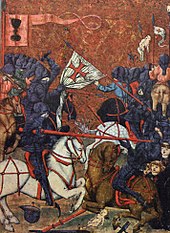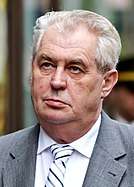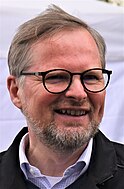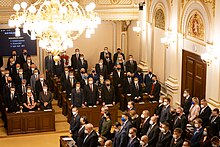A | B | C | D | E | F | G | H | CH | I | J | K | L | M | N | O | P | Q | R | S | T | U | V | W | X | Y | Z | 0 | 1 | 2 | 3 | 4 | 5 | 6 | 7 | 8 | 9
Coordinates: 49°45′N 15°30′E / 49.750°N 15.500°E
Czech Republic Česká republika (Czech) | |
|---|---|
| Motto: Pravda vítězí (Czech) (English: "Truth prevails") | |
| Anthem: Kde domov můj (Czech) (English: "Where is my home") | |
 Location of the Czech Republic (dark green) – in Europe (green & dark gray) | |
| Capital and largest city | Prague 50°05′N 14°28′E / 50.083°N 14.467°E |
| Official language | Czech[1] |
| Officially recognized languages[2][3] | |
| Ethnic groups (2021)[4] |
|
| Religion (2021)[5] |
|
| Demonym(s) | Czech |
| Government | Unitary parliamentary republic |
| Miloš Zeman | |
| Petr Fiala | |
| Legislature | Parliament |
| Senate | |
| Chamber of Deputies | |
| Establishment history | |
| c. 870 | |
| 1198 | |
| 28 October 1918 | |
| 1 January 1993 | |
| Area | |
• Total | 78,871 km2 (30,452 sq mi) (115th) |
• Water (%) | 2.12 (as of 2020)[6] |
| Population | |
• 2022 estimate | |
• 2021 census | |
• Density | 133/km2 (344.5/sq mi) (91st) |
| GDP (PPP) | 2022 estimate |
• Total | |
• Per capita | |
| GDP (nominal) | 2022 estimate |
• Total | |
• Per capita | |
| Gini (2020) | low |
| HDI (2019) | very high · 27th |
| Currency | Czech koruna (CZK) |
| Time zone | UTC+1 (CET) |
• Summer (DST) | UTC+2 (CEST) |
| Date format | d. m. yyyy |
| Driving side | right |
| Calling code | +420 |
| ISO 3166 code | CZ |
| Internet TLD | .cz |
The Czech Republic,[a][12] also called Czechia[b][13] is a landlocked country in Central Europe. Historically known as Bohemia,[14] it is bordered by Austria to the south, Germany to the west, Poland to the northeast, and Slovakia to the southeast.[15] The Czech Republic has a hilly landscape that covers an area of 78,871 square kilometers (30,452 sq mi) with a mostly temperate continental and oceanic climate. The capital and largest city is Prague; other major cities and urban areas include Brno, Ostrava, Plzeň and Liberec.
The Duchy of Bohemia was founded in the late 9th century under Great Moravia. It was formally recognized as an Imperial State of the Holy Roman Empire in 1002 and became a kingdom in 1198.[16][17] Following the Battle of Mohács in 1526, the whole Crown of Bohemia was gradually integrated into the Habsburg monarchy. The Protestant Bohemian Revolt led to the Thirty Years' War. After the Battle of the White Mountain, the Habsburgs consolidated their rule. With the dissolution of the Holy Empire in 1806, the Crown lands became part of the Austrian Empire.
In the 19th century, the Czech lands became more industrialized, and in 1918 most of it became part of the First Czechoslovak Republic following the collapse of Austria-Hungary after World War I.[18] Czechoslovakia was the only country in Central and Eastern Europe to remain a parliamentary democracy during the entirety of the interwar period.[19] After the Munich Agreement in 1938, Nazi Germany systematically took control over the Czech lands. Czechoslovakia was restored in 1945 and became an Eastern Bloc communist state following a coup d'état in 1948. Attempts to liberalize the government and economy were suppressed by a Soviet-led invasion of the country during the Prague Spring in 1968. In November 1989, the Velvet Revolution ended communist rule in the country, and on 1 January 1993, Czechoslovakia was dissolved, with its constituent states becoming the independent states of the Czech Republic and Slovakia.
The Czech Republic is a unitary parliamentary republic and developed country with an advanced, high-income social market economy. It is a welfare state with a European social model, universal health care and tuition-free university education. It ranks 12th in the UN inequality-adjusted human development and 24th in the World Bank Human Capital Index. It ranks as the 9th safest and most peaceful country and 31st in democratic governance. The Czech Republic is a member of NATO, the European Union, OECD, OSCE, and the Council of Europe.
Name
The traditional English name "Bohemia" derives from Latin: Boiohaemum, which means "home of the Boii" (Gallic tribe). The current English name comes from the Polish ethnonym associated with the area, which ultimately comes from the Czech word Čech.[20][21][22] The name comes from the Slavic tribe (Czech: Češi, Čechové) and, according to legend, their leader Čech, who brought them to Bohemia, to settle on Říp Mountain. The etymology of the word Čech can be traced back to the Proto-Slavic root *čel-, meaning "member of the people; kinsman", thus making it cognate to the Czech word člověk (a person).[23]
The country has been traditionally divided into three lands, namely Bohemia (Čechy) in the west, Moravia (Morava) in the east, and Czech Silesia (Slezsko; the smaller, south-eastern part of historical Silesia, most of which is located within modern Poland) in the northeast.[24] Known as the lands of the Bohemian Crown since the 14th century, a number of other names for the country have been used, including Czech/Bohemian lands, Bohemian Crown, Czechia[25] and the lands of the Crown of Saint Wenceslaus. When the country regained its independence after the dissolution of the Austro-Hungarian empire in 1918, the new name of Czechoslovakia was coined to reflect the union of the Czech and Slovak nations within one country.[26]
After Czechoslovakia dissolved in 1992, the Czech Ministry of Foreign Affairs recommended Czechia for the English short name.[27] This form was not adopted at the time, leading to the long name Czech Republic being used in all circumstances. The Czech government approved Czechia as the official English short name in 2016.[28] The short name has been listed by the United Nations[29] and is used by other organizations such as the European Union,[30] the CIA,[31] and Google Maps.[32]
History
Prehistory
Right: The stone head of a Celt is among the archaeological collections of the National Museum.[33]
Archaeologists have found evidence of prehistoric human settlements in the area, dating back to the Paleolithic era.
In the classical era, as a result of the 3rd century BC Celtic migrations, Bohemia became associated with the Boii.[34] The Boii founded an oppidum near the site of modern Prague.[35] Later in the 1st century, the Germanic tribes of the Marcomanni and Quadi settled there.[36]
Slavs from the Black Sea–Carpathian region settled in the area (their migration was pushed by an invasion of peoples from Siberia and Eastern Europe into their area:[37] Huns, Avars, Bulgars and Magyars).[38] In the sixth century, the Huns had moved westwards into Bohemia, Moravia, and some of present-day Austria and Germany.[38]
During the 7th century, the Frankish merchant Samo, supporting the Slavs fighting against nearby settled Avars,[39] became the ruler of the first documented Slavic state in Central Europe, Samo's Empire. The principality of Great Moravia, controlled by Moymir dynasty, arose in the 8th century.[40] It reached its zenith in the 9th (during the reign of Svatopluk I of Moravia), holding off the influence of the Franks. Great Moravia was Christianized, with a role being played by the Byzantine mission of Cyril and Methodius. They codified the Old Church Slavonic language, the first literary and liturgical language of the Slavs, and the Glagolitic alphabet.[41]
Bohemia
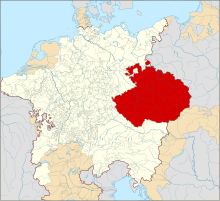
The Duchy of Bohemia emerged in the late 9th century when it was unified by the Přemyslid dynasty. Bohemia was from 1002 until 1806 an Imperial State of the Holy Roman Empire.[42]
In 1212, Přemysl Ottokar I extracted the Golden Bull of Sicily from the emperor, confirming Ottokar and his descendants' royal status; the Duchy of Bohemia was raised to a Kingdom.[43] German immigrants settled in the Bohemian periphery in the 13th century.[44] The Mongols in the invasion of Europe carried their raids into Moravia but were defensively defeated at Olomouc.[45]
After a series of dynastic wars, the House of Luxembourg gained the Bohemian throne.[46]
Efforts for a reform of the church in Bohemia started already in the late 14th century. Jan Hus's followers seceded from some practices of the Roman Church and in the Hussite Wars (1419–1434) defeated five crusades organized against them by Sigismund. During the next two centuries, 90% of the population in Bohemia and Moravia were considered Hussites. The pacifist thinker Petr Chelčický inspired the movement of the Moravian Brethren (by the middle of the 15th century) that completely separated from the Roman Catholic Church.[47]
On 21 December 1421, Jan Žižka, a successful military commander and mercenary, led his group of forces in the Battle of Kutná Hora, resulting in a victory for the Hussites. He is honoured to this day as a national hero.
After 1526 Bohemia came increasingly under Habsburg control as the Habsburgs became first the elected and then in 1627 the hereditary rulers of Bohemia. Between 1583 and 1611 Prague was the official seat of the Holy Roman Emperor Rudolf II and his court.
The Defenestration of Prague and subsequent revolt against the Habsburgs in 1618 marked the start of the Thirty Years' War. In 1620, the rebellion in Bohemia was crushed at the Battle of White Mountain and the ties between Bohemia and the Habsburgs' hereditary lands in Austria were strengthened. The leaders of the Bohemian Revolt were executed in 1621. The nobility and the middle class Protestants had to either convert to Catholicism or leave the country.[48]
In the "Dark Age" of 1620 to the late 18th century, the population of the Czech lands declined by a third through the expulsion of Czech Protestants as well as due to the war, disease and famine.[49] The Habsburgs prohibited all Christian confessions other than Catholicism.[50] The flowering of Baroque culture shows the ambiguity of this historical period. Ottoman Turks and Tatars invaded Moravia in 1663.[51] In 1679–1680 the Czech lands faced the Great Plague of Vienna and an uprising of serfs.[52]

There were peasant uprisings influenced by famine.[53] Serfdom was abolished between 1781 and 1848. Several battles of the Napoleonic Wars took place on the current territory of the Czech Republic.
The end of the Holy Roman Empire in 1806 led to degradation of the political status of Bohemia which lost its position of an electorate of the Holy Roman Empire as well as its own political representation in the Imperial Diet.[54] Bohemian lands became part of the Austrian Empire. During the 18th and 19th century the Czech National Revival began its rise, with the purpose to revive Czech language, culture, and national identity. The Revolution of 1848 in Prague, striving for liberal reforms and autonomy of the Bohemian Crown within the Austrian Empire, was suppressed.[55]
It seemed that some concessions would be made also to Bohemia, but in the end, the Emperor Franz Joseph I affected a compromise with Hungary only. The Austro-Hungarian Compromise of 1867 and the never realized coronation of Franz Joseph as King of Bohemia led to a disappointment of some Czech politicians.[55] The Bohemian Crown lands became part of the so-called Cisleithania.
The Czech Social Democratic and progressive politicians started the fight for universal suffrage. The first elections under universal male suffrage were held in 1907.[56]
Czechoslovakia
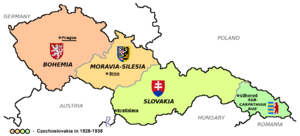
In 1918, during the collapse of the Habsburg monarchy at the end of World War I, the independent republic of Czechoslovakia, which joined the winning Allied powers, was created, with Tomáš Garrigue Masaryk in the lead.[58] This new country incorporated the Bohemian Crown.[59]
The First Czechoslovak Republic comprised only 27% of the population of the former Austria-Hungary, but nearly 80% of the industry, which enabled it to compete with Western industrial states.[57] In 1929 compared to 1913, the gross domestic product increased by 52% and industrial production by 41%. In 1938 Czechoslovakia held 10th place in the world industrial production.[60] Czechoslovakia was the only country in Central and Eastern Europe to remain a democracy throughout the entire interwar period.[61] Although the First Czechoslovak Republic was a unitary state, it provided certain rights to its minorities, the largest being Germans (23.6% in 1921), Hungarians (5.6%) and Ukrainians (3.5%).[62]

Western Czechoslovakia was occupied by Nazi Germany, which placed most of the region into the Protectorate of Bohemia and Moravia. The Protectorate was proclaimed part of the Third Reich, and the president and prime minister were subordinated to Nazi Germany's Reichsprotektor. One Nazi concentration camp was located within the Czech territory at Terezín, north of Prague. The vast majority of the Protectorate's Jews were murdered in Nazi-run concentration camps. The Nazi Generalplan Ost called for the extermination, expulsion, Germanization or enslavement of most or all Czechs for the purpose of providing more living space for the German people.[63] There was Czechoslovak resistance to Nazi occupation as well as reprisals against the Czechoslovaks for their anti-Nazi resistance. The German occupation ended on 9 May 1945, with the arrival of the Soviet and American armies and the Prague uprising.[64] Most of Czechoslovakia's German-speakers were forcibly expelled from the country, first as a result of local acts of violence and then under the aegis of an "organized transfer" sanctified by the Soviet Union, the United States, and Great Britain at the Potsdam Conference.[65]
In the 1946 elections, the Communist Party gained 38%[66] of the votes and became the largest party in the Czechoslovak parliament, formed a coalition with other parties, and consolidated power. A coup d'état came in 1948 and a single-party government was formed. For the next 41 years, the Czechoslovak Communist state is characterized by certain Eastern Bloc's economic and political features.[67] The Prague Spring political liberalization was stopped by the 1968 Warsaw Pact invasion of Czechoslovakia. Analysts believe that the invasion caused the communist movement to fracture, ultimately leading to the Revolutions of 1989.
Czech Republic
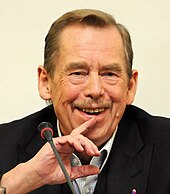
In November 1989, Czechoslovakia returned to a liberal democracy through the Velvet Revolution. However, Slovak national aspirations strengthened (Hyphen War) and on 1 January 1993, the country peacefully split into the independent countries of the Czech Republic and Slovakia. Both countries went through economic reforms and privatizations, with the intention of creating a market economy. This process was largely successful; in 2006 the Czech Republic was recognized by the World Bank as a "developed country",[68] and in 2009 the Human Development Index ranked it as a nation of "Very High Human Development".[69]
From 1991, the Czech Republic, originally as part of Czechoslovakia and since 1993 in its own right, has been a member of the Visegrád Group and from 1995, the OECD. The Czech Republic joined NATO on 12 March 1999 and the European Union on 1 May 2004. On 21 December 2007 the Czech Republic joined the Schengen Area.[70]
Until 2017, either the Czech Social Democratic Party or the Civic Democratic Party led the governments of the Czech Republic. In October 2017, populist movement ANO 2011, led by the country's second-richest man, Andrej Babiš, won the elections with three times more votes than its closest rival, the centre-right Civic Democrats.[71] In December 2017, Czech President Miloš Zeman appointed Andrej Babiš as the new prime minister.[72]
After the results of the elections in October 2021, Petr Fiala became the new Prime Minister. He formed a government coalition of the Alliance SPOLU (Civic Democratic Party, KDU-ČSL and TOP 09) and the Alliance of Pirates and Mayors. In the election the ANO movement was narrowly defeated.[73]
Geography
The Czech Republic lies mostly between latitudes 48° and 51° N and longitudes 12° and 19° E.
Bohemia, to the west, consists of a basin drained by the Elbe (Czech: Labe) and the Vltava rivers, surrounded by mostly low mountains, such as the Krkonoše range of the Sudetes. The highest point in the country, Sněžka at 1,603 m (5,259 ft), is located here. Moravia, the eastern part of the country, is also hilly. It is drained mainly by the Morava River, but it also contains the source of the Oder River (Czech: Odra).
Water from the Czech Republic flows to three different seas: the North Sea, Baltic Sea, and Black Sea. The Czech Republic also leases the Moldauhafen, a 30,000-square-meter (7.4-acre) lot in the middle of the Hamburg Docks, which was awarded to Czechoslovakia by Article 363 of the Treaty of Versailles, to allow the landlocked country a place where goods transported down river could be transferred to seagoing ships. The territory reverts to Germany in 2028.
Phytogeographically, the Czech Republic belongs to the Central European province of the Circumboreal Region, within the Boreal Kingdom. According to the World Wide Fund for Nature, the territory of the Czech Republic can be subdivided into four ecoregions: the Western European broadleaf forests, Central European mixed forests, Pannonian mixed forests, and Carpathian montane conifer forests.[74]
There are four national parks in the Czech Republic. The oldest is Krkonoše National Park (Biosphere Reserve), and the others are Šumava National Park (Biosphere Reserve), Podyjí National Park, Bohemian Switzerland.
The three historical lands of the Czech Republic (formerly some countries of the Bohemian Crown) correspond with the river basins of the Elbe and the Vltava basin for Bohemia, the Morava one for Moravia, and the Oder river basin for Czech Silesia (in terms of the Czech territory).
Climate

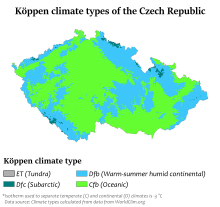
The Czech Republic has a temperate climate, situated in the transition zone between the oceanic and continental climate types, with warm summers and cold, cloudy and snowy winters. The temperature difference between summer and winter is due to the landlocked geographical position.[75]
Temperatures vary depending on the elevation. In general, at higher altitudes, the temperatures decrease and precipitation increases. The wettest area in the Czech Republic is found around Bílý Potok in Jizera Mountains and the driest region is the Louny District to the northwest of Prague. Another factor is the distribution of the mountains.
At the highest peak of Sněžka (1,603 m or 5,259 ft), the average temperature is −0.4 °C (31 °F), whereas in the lowlands of the South Moravian Region, the average temperature is as high as 10 °C (50 °F). The country's capital, Prague, has a similar average temperature, although this is influenced by urban factors.
The coldest month is usually January, followed by February and December. During these months, there is snow in the mountains and sometimes in the cities and lowlands. During March, April, and May, the temperature usually increases, especially during April, when the temperature and weather tends to vary during the day. Spring is also characterized by higher water levels in the rivers, due to melting snow with occasional flooding.
The warmest month of the year is July, followed by August and June. On average, summer temperatures are about 20–30 °C (36–54 °F) higher than during winter. Summer is also characterized by rain and storms.
Autumn generally begins in September, which is still warm and dry. During October, temperatures usually fall below 15 °C (59 °F) or 10 °C (50 °F) and deciduous trees begin to shed their leaves. By the end of November, temperatures usually range around the freezing point.
The coldest temperature ever measured was in Litvínovice near České Budějovice in 1929, at −42.2 °C (−44.0 °F) and the hottest measured, was at 40.4 °C (104.7 °F) in Dobřichovice in 2012.[76]
Most rain falls during the summer. Sporadic rainfall is throughout the year (in Prague, the average number of days per month experiencing at least 0.1 mm (0.0039 in) of rain varies from 12 in September and October to 16 in November) but concentrated rainfall (days with more than 10 mm (0.39 in) per day) are more frequent in the months of May to August (average around two such days per month).[77] Severe thunderstorms, producing damaging straight-line winds, hail, and occasional tornadoes occur, especially during the summer period.[78][79]
Examples
| Climate data for Prague (1981–2010 normals, extremes 1775-present) | |||||||||||||
|---|---|---|---|---|---|---|---|---|---|---|---|---|---|
| Month | Jan | Feb | Mar | Apr | May | Jun | Jul | Aug | Sep | Oct | Nov | Dec | Year |
| Record high °C (°F) | 17.4 (63.3) |
19.2 (66.6) |
22.5 (72.5) |
28.8 (83.8) |
32.5 (90.5) |
37.9 (100.2) |
37.8 (100.0) |
37.4 (99.3) |
33.1 (91.6) |
27.0 (80.6) |
19.5 (67.1) |
17.4 (63.3) |
37.9 (100.2) |
| Average high °C (°F) | 2.6 (36.7) |
4.4 (39.9) |
9.1 (48.4) |
15.1 (59.2) |
20.3 (68.5) |
22.8 (73.0) |
25.3 (77.5) |
25.1 (77.2) |
19.9 (67.8) |
14.2 (57.6) |
7.2 (45.0) |
3.4 (38.1) |
14.1 (57.4) |
| Daily mean °C (°F) | 0.1 (32.2) |
1.3 (34.3) |
5.3 (41.5) |
10.1 (50.2) |
15.0 (59.0) |
17.8 (64.0) |
19.9 (67.8) |
19.6 (67.3) |
15.2 (59.4) |
10.3 (50.5) |
4.6 (40.3) |
1.1 (34.0) |
10.0 (50.0) |
| Average low °C (°F) | −2.4 (27.7) |
−1.8 (28.8) |
1.5 (34.7) |
5.1 (41.2) |
9.7 (49.5) |
12.7 (54.9) |
14.5 (58.1) |
14.2 (57.6) |
10.5 (50.9) |
6.4 (43.5) |
2.1 (35.8) |
−1.1 (30.0) |
6.0 (42.7) |
| Record low °C (°F) | −27.5 (−17.5) |
−27.1 (−16.8) |
−27.6 (−17.7) |
−8 (18) |
−2.3 (27.9) |
1.9 (35.4) |
6.7 (44.1) |
6.4 (43.5) |
0.7 (33.3) |
−7.5 (18.5) |
−16.9 (1.6) |
−24.8 (−12.6) |
−27.6 (−17.7) |
| Average precipitation mm (inches) | 34 (1.3) |
30 (1.2) |
40 (1.6) |
34 (1.3) |
63 (2.5) |
70 (2.8) |
82 (3.2) |
75 (3.0) |
47 (1.9) |
34 (1.3) |
40 (1.6) |
38 (1.5) |
587 (23.1) |
| Average snowfall cm (inches) | 17.9 (7.0) |
15.9 (6.3) |
10.3 (4.1) |
2.9 (1.1) |
0.0 (0.0) |
0.0 (0.0) |
0.0 (0.0) |
0.0 (0.0) |
0.0 (0.0) |
0.1 (0.0) |
8.4 (3.3) |
15.9 (6.3) |
71.4 (28.1) |
| Average precipitation days | 5.7 | 5.2 | 6.6 | 5.8 | 8.5 | 9.4 | 8.9 | 8.4 | 7.3 | 5.5 | 7.1 | 5.9 | 84.3 |
| Average relative humidity (%) | 86 | 83 | 77 | 69 | 70 | 71 | 70 | 71 | 76 | 81 | 87 | 88 | 77 |
| Average dew point °C (°F) | −4.6 (23.7) |
−3.5 (25.7) |
−1.1 (30.0) |
2.0 (35.6) |
7.0 (44.6) |
10.3 (50.5) |
11.6 (52.9) |
11.5 (52.7) |
9.1 (48.4) |
5.1 (41.2) |
0.6 (33.1) |
−2.9 (26.8) |
3.8 (38.8) |
| Mean monthly sunshine hours | 50.0 | 72.4 | 124.7 | 167.6 | 214.0 | 218.3 | 226.2 | 212.3 | 161.0 | 120.8 | 53.9 | 46.7 | 1,667.9 |
| Average ultraviolet index | 1 | 1 | 3 | 4 | 6 | 7 | 6 | 6 | 4 | 2 | 1 | 1 | 4 |
| Source: World Meteorological Organization (temperature and rainfall 1981–2010)[80] NOAA[81] and Weather Atlas[82] | |||||||||||||
| Climate data for Prague (1991−2020 normals) | |||||||||||||
|---|---|---|---|---|---|---|---|---|---|---|---|---|---|
| Month | Jan | Feb | Mar | Apr | May | Jun | Jul | Aug | Sep | Oct | Nov | Dec | Year |
| Average high °C (°F) | 2.9 (37.2) |
5.7 (42.3) |
9.9 (49.8) |
16.3 (61.3) |
20.6 (69.1) |
24.1 (75.4) |
26.0 (78.8) |
26.0 (78.8) |
20.6 (69.1) |
14.9 (58.8) |
8.0 (46.4) |
3.8 (38.8) |
14.9 (58.8) |
| Daily mean °C (°F) | 0.4 (32.7) |
2.4 (36.3) |
5.6 (42.1) |
10.8 (51.4) |
15.0 (59.0) |
18.6 (65.5) |
20.4 (68.7) |
20.2 (68.4) |
15.6 (60.1) |
10.8 (51.4) |
5.3 (41.5) |
1.5 (34.7) |
10.5 (51.0) |
| Average low °C (°F) | −2.1 (28.2) |
−1.0 (30.2) |
1.4 (34.5) |
5.3 (41.5) |
9.5 (49.1) |
13.1 (55.6) |
14.7 (58.5) |
14.4 (57.9) |
10.5 (50.9) |
6.6 (43.9) |
2.6 (36.7) |
−0.8 (30.6) |
6.2 (43.1) |
| Average precipitation mm (inches) | 25.8 (1.02) |
21.8 (0.86) |
31.4 (1.24) |
26.8 (1.06) |
65.1 (2.56) |
79.7 (3.14) |
75.9 (2.99) |
77.3 (3.04) |
44.2 (1.74) |
35.4 (1.39) |
30.0 (1.18) |
29.7 (1.17) |
543.1 (21.39) |
| Mean monthly sunshine hours | 53.1 | 82.9 | 128.1 | 192.5 | 220.4 | 230.0 | 240.0 | 227.6 | 163.5 | 109.9 | 48.9 | 43.3 | 1,740.2 |
| Source: Meteostat[83] | |||||||||||||
| Climate data for Brno (Brno–Tuřany Airport), 1981–2010 normals, extremes 1939-present | |||||||||||||
|---|---|---|---|---|---|---|---|---|---|---|---|---|---|
| Month | Jan | Feb | Mar | Apr | May | Jun | Jul | Aug | Sep | Oct | Nov | Dec | Year |
| Record high °C (°F) | 16.0 (60.8) |
17.6 (63.7) |
24.0 (75.2) |
29.5 (85.1) |
31.8 (89.2) |
36.6 (97.9) |
36.4 (97.5) |
37.8 (100.0) |
32.2 (90.0) |
27.7 (81.9) |
19.3 (66.7) |
19.0 (66.2) |
37.8 (100.0) |
| Average high °C (°F) | 1.1 (34.0) |
3.6 (38.5) |
8.7 (47.7) |
15.1 (59.2) |
20.1 (68.2) |
23.0 (73.4) |
25.6 (78.1) |
25.4 (77.7) |
20.0 (68.0) |
13.8 (56.8) |
6.9 (44.4) |
2.0 (35.6) |
13.8 (56.8) |
| Daily mean °C (°F) | −2.5 (27.5) |
−0.3 (31.5) |
3.8 (38.8) |
9.0 (48.2) |
13.9 (57.0) |
17.0 (62.6) |
18.5 (65.3) |
18.1 (64.6) |
14.3 (57.7) |
9.1 (48.4) |
3.5 (38.3) |
−0.6 (30.9) |
8.7 (47.7) |
| Average low °C (°F) | −4.3 (24.3) |
−3.3 (26.1) |
0.2 (32.4) |
4.5 (40.1) |
9.3 (48.7) |
12.1 (53.8) |
14.0 (57.2) |
13.8 (56.8) |
10.0 (50.0) |
5.7 (42.3) |
1.1 (34.0) |
−2.9 (26.8) |
5.0 (41.0) |
| Record low °C (°F) | −24.1 (−11.4) |
−22.2 (−8.0) |
−18.9 (−2.0) |
−7 (19) |
−2.8 (27.0) |
0.0 (32.0) |
1.1 (34.0) |
2.8 (37.0) |
−2.2 (28.0) |
−6.5 (20.3) |
−13 (9) |
−21 (−6) |
−24.1 (−11.4) |
| Average precipitation mm (inches) | 23.1 (0.91) |
23.4 (0.92) |
29.7 (1.17) |
28.9 (1.14) |
61.2 (2.41) |
72.2 (2.84) |
69.0 (2.72) |
55.7 (2.19) |
47.9 (1.89) |
31.1 (1.22) |
34.0 (1.34) |
31.9 (1.26) |
508.1 (20.00) |
| Average snowfall cm (inches) | 17.4 (6.9) |
12.4 (4.9) |
5.2 (2.0) |
0.6 (0.2) |
0.0 (0.0) |
0.0 (0.0) |
0.0 (0.0) |
0.0 (0.0) |
0.0 (0.0) |
0.0 (0.0) |
4.5 (1.8) |
12.5 (4.9) |
52.6 (20.7) |
| Average precipitation days | 5.8 | 5.3 | 6.4 | 5.7 | 8.1 | 8.6 | 9.1 | 7.4 | 6.5 | 6.3 | 7.1 | 7.5 | 83.8 |
| Average relative humidity (%) | 84 | 81 | 73 | 65 | 67 | 69 | 67 | 68 | 73 | 78 | 84 | 85 | 75 |
| Mean monthly sunshine hours | 53.8 | 82.9 | 137.5 | 208.7 | 226.4 | 246.9 | 245.7 | 246.3 | 175.5 | 112.5 | 59.3 | 44.5 | 1,840 |
| Average ultraviolet index | 1 | 1 | 3 | 4 | 6 | 7 | 7 | 6 | 4 | 2 | 1 | 1 | 4 |
| Source 1: World Meteorological Organization (UN)[84] | |||||||||||||
| Source 2: NOAA[85] | |||||||||||||
| Climate data for Ostrava (1981−2010 normals, extremes 1980−present) | |||||||||||||
|---|---|---|---|---|---|---|---|---|---|---|---|---|---|
| Month | Jan | Feb | Mar | Apr | May | Jun | Jul | Aug | Sep | Oct | Nov | Dec | Year |
| Record high °C (°F) | 14.2 (57.6) |
17.3 (63.1) |
22.8 (73.0) |
29.0 (84.2) |
31.9 (89.4) |
35.2 (95.4) |
36.7 (98.1) |
36.9 (98.4) |
33.7 (92.7) |
26.2 (79.2) |
22.5 (72.5) |
16.7 (62.1) |
36.9 (98.4) |
| Average high °C (°F) | 0.4 (32.7) |
2.8 (37.0) |
7.7 (45.9) |
13.5 (56.3) |
18.9 (66.0) |
21.9 (71.4) |
23.6 (74.5) |
23.4 (74.1) |
19.4 (66.9) |
14.0 (57.2) |
6.7 (44.1) |
2.0 (35.6) |
12.9 (55.1) |
| Average low °C (°F) | −5.6 (21.9) |
−4.1 (24.6) |
−0.8 (30.6) |
3.0 (37.4) |
7.3 (45.1) |
10.6 (51.1) |
11.9 (53.4) |
11.6 (52.9) |
8.7 (47.7) |
4.7 (40.5) |
0.9 (33.6) |
−3.2 (26.2) |
3.7 (38.7) |
| Record low °C (°F) | −29.3 (−20.7) |
−24.7 (−12.5) |
−21.9 (−7.4) |
−7.8 (18.0) |
−3.0 (26.6) |
1.2 (34.2) |
4.2 (39.6) |
3.8 (38.8) |
−0.6 (30.9) |
−7.6 (18.3) |
−18.7 (−1.7) |
−25.8 (−14.4) |
−29.3 (−20.7) |
| Average precipitation mm (inches) | 26.7 (1.05) |
30.2 (1.19) |
34.0 (1.34) |
52.4 (2.06) |
91.2 (3.59) |
104.4 (4.11) |
91.1 (3.59) |
91.8 (3.61) |
58.8 (2.31) |
42.3 (1.67) |
44.6 (1.76) |
34.3 (1.35) |
701.8 (27.63) |
| Average precipitation days | 7 | 7 | 7 | 8 | 11 | 11 | 11 | 10 | 8 | 7 | 9 | 8 | 104 |
| Source 1: World Meteorological Organisation (UN)[86] | |||||||||||||
| Source 2: infoclimat.fr[87] | |||||||||||||
Environment
As of 2020, the Czech Republic ranks as the 21st most environmentally conscious country in the world in Environmental Performance Index.[88] It had a 2018 Forest Landscape Integrity Index mean score of 1.71/10, ranking it 160th globally out of 172 countries.[89] The Czech Republic has four National Parks (Šumava National Park, Krkonoše National Park, České Švýcarsko National Park, Podyjí National Park) and 25 Protected Landscape Areas.
Government
The Czech Republic is a pluralist multi-party parliamentary representative democracy. The Parliament (Parlament České republiky) is bicameral, with the Chamber of Deputies (Czech: Poslanecká sněmovna, 200 members) and the Senate (Czech: Senát, 81 members).[90] The members of the Chamber of Deputies are elected for a four-year term by proportional representation, with a 5% election threshold. There are 14 voting districts, identical to the country's administrative regions. The Chamber of Deputies, the successor to the Czech National Council, has the powers and responsibilities of the now defunct federal parliament of the former Czechoslovakia. The members of the Senate are elected in single-seat constituencies by two-round runoff voting for a six-year term, with one-third elected every even year in the autumn. This arrangement is modeled on the U.S. Senate, but each constituency is roughly the same size and the voting system used is a two-round runoff.
The president is a formal head of state with limited and specific powers, who appoints the prime minister, as well the other members of the cabinet on a proposal by the prime minister. From 1993 until 2012, the President of the Czech Republic was selected by a joint session of the parliament for a five-year term, with no more than two consecutive terms (2x Václav Havel, 2x Václav Klaus). Since 2013 the presidential election is direct.[91] Some commentators have argued that, with the introduction of direct election of the President, the Czech Republic has moved away from the parliamentary system and towards a semi-presidential one.[92] The Government's exercise of executive power derives from the Constitution. The members of the government are the Prime Minister, Deputy prime ministers and other ministers. The Government is responsible to the Chamber of Deputies.[93] The Prime Minister is the head of government and wields powers such as the right to set the agenda for most foreign and domestic policy and choose government ministers.[94]




